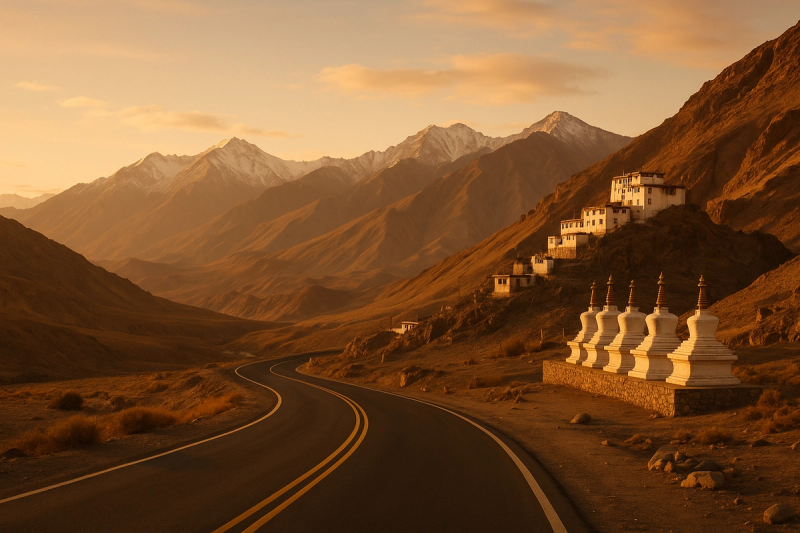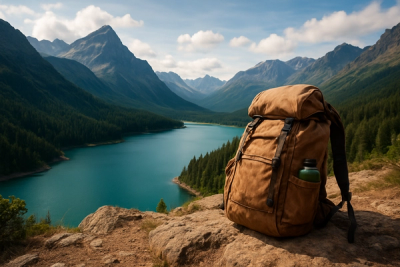Leh Ladakh Road Trip 2026: Routes, Experiences & Permits — from one desi traveler to another#
I finally did it. Packed the car, chucked a stupid number of Maggi packets, and drove into that moonscape they call Ladakh. Honestly, I thought I was ready. Maps downloaded, playlist sorted, parents convinced, permits—well, that part gets interesting. But the first time the mountains opened up near Lamayuru and the wind was just, like, singing in the car... man. Goosebumps. You think you’ve seen mountains in Himachal or Uttarakhand and then Ladakh just goes haan ji, hold my butter tea.¶
Best months, current vibe, and safety stuff#
Timing matters big time here. Classic window: late May to mid-October for road trips. Early season (May–June) means snow walls and ferocious passes but fewer crowds. July–August is technically monsoon elsewhere, but Ladakh is rain-shadow. Still, cloudbursts and landslides do happen—esp. on approach roads like Zoji La and near Baralacha La—so keep 1-2 buffer days. September and early October are pure chef’s kiss: clear skies, golden poplars, cold nights. After that, most high passes close. As of late 2025, BRO has been super active, but closures can come overnight. Just check DC Leh updates on X (Twitter) and the Leh Police page before moving. Don’t push it. If locals say wait, you wait.¶
Routes that actually make sense (and don’t break your soul)#
There are three main ways to do a Leh road trip. Each one has its mood, your vibe might choose differently. I’ve done Srinagar–Leh out and Manali–Leh back, and snuck a taste of the Zanskar link too. If you’re driving from the plains, the loop is ideal—enter from Srinagar side to acclimatize gentler, exit via Manali once your body has figured out thin air.¶
1) Srinagar → Kargil → Leh (NH-1, via Zoji La)#
- Open approx late Apr/May till Nov, depending on snowfall. Zoji La is the gatekeeper.
- Sonamarg meadows → Drass War Memorial (must-stop, take 45 mins at least) → Kargil biryani and apricots → Moonland at Lamayuru → Magnetic Hill and Sangam.
- Road is generally better vs Manali-Leh. Fewer high-altitude pass shocks early on, which your lungs will thank you for.
2) Manali → Jispa → Sarchu → Leh (via Atal Tunnel, Baralacha La, Nakee La, Lachulung La, Tanglang La)#
- Opens around late May/June to Oct-ish. Atal Tunnel makes Rohtang painless, but the big passes ahead are no joke.
- Stays: Keylong/Jispa for a sane first night. Sarchu is scenic but high; many folks wake up with a hammer in the head. I did. Not cute.
- Views are insane. More raw. More “what am I even doing here” energy. But also more fatigue.
3) The Zanskar link: Darcha → Shinku La → Padum → Nimmu/Leh (work in progress but wow)#
BRO keeps improving this one. Windows are shorter, surfaces change from smooth to lunar in 10 mins. If it’s open when you go, it’s a dream for explorers. Padum to Leh via Nimmu gives a totally different Ladakh story—fewer crowds, more conversations. Check local updates same morning you move.¶
Permits, fees, and that confusing ILP talk#
Short version, don’t panic. For Indian nationals, the old-school Inner Line Permit (ILP) for Leh district tourist circuits is not required anymore. What you DO need: pay the environment/green fee and Red Cross contribution (you can do it online through the LAHDC Leh portal or at the Tourist Information Centre). It’s usually around Rs 500-600 per person for green fee plus about Rs 100 Red Cross donation, and a small per-day wildlife fee when you hit protected areas. Keep multiple printouts/soft copies. Army/ITBP checkposts sometimes ask, sometimes just wave you on. Foreign nationals still require Protected Area Permit (PAP), processed via registered agents. Different scene.¶
Now the tricky bits. Some routes near the LAC—like Pangong to Hanle via Chushul, Tsaga, or Hanle to Umling La—can flip from open to shut depending on current conditions. Even Indians might be turned back if the post says nope today. Drones are restricted without permissions, don’t mess around near the border. Always carry 8-10 photocopies of your ID, vehicle papers, and fee receipt. The “rules” are simple but also not. Best is ask at TIC Leh on Day 1, they’ll tell you what’s open real-time.¶
- Checklist: Valid ID, vehicle RC/PUC/insurance, driving license, postpaid SIM (prepaid from outside J&K/Ladakh usually won’t work), green fee receipt, and lots of patience.
Acclimatization: don’t be a hero, yaar#
Ladakh has no time for your ego. Give yourself 36–48 hours in Leh before big sightseeing. I usually do chill: market stroll, Shanti Stupa sunset, hearty thukpa. No running, no stairs race, no alcohol first two nights. Hydrate like its your job. Diamox helps some folks (ask your doc), but basic rule is ascend slow, sleep lower if you can. If you feel headache + nausea + weird fatigue, descend or rest. Oxygen cans are placebo-ish; better is not pushing. Your trip is not a race.¶
What it actually felt like out there#
Khardung La came in a burst of prayer flags and thin, sharp light. You park, shuffle a bit, laugh at your own silly breathlessness. I had a chai that tasted like victory and diesel. In Nubra, a local aunty in Sumur scolded me for not eating enough—then served skyu that cured my soul. And Pangong at night… the stars are so many it’s almost uncomfortable, like the sky is too honest. I sat outside the tent with a lukewarm kahwa just listening to water lapping, feeling very tiny and very okay with it. Next morning the lake switched from grey to electric blue in seconds. Cameras dont even try.¶
Stays, budgets, and what’s become trendy lately#
Leh has every kind of stay now. Clean guesthouses in Changspa or Upper Tukcha for Rs 1200–2500 per room. Mid-range hotels with heaters and buffets—Rs 3000–7000. Fancy places? 9–15k+. Nubra and Pangong have homestays and tented camps: expect Rs 1500–2500 per person with meals in homestays, and Rs 2500–5000 per person in camps depending on how close you are to the lake. Hanle homestays are simple, warm, and some are astro-themed now since it’s a Dark Sky Reserve. Super cool.¶
Taxis in Ladakh follow union rates—budget like 15–20k for a 2D/1N Nubra run in an SUV, 8–12k for Leh–Pangong drop/return, a bit more if combining circuits. Bikes: Royal Enfield 350/411 go for 1200–1800 per day, check brakes and clutch before taking off. Fuel is pricier than plains. EVs are starting to show up—Leh has a few public chargers around town and at some hotels, and a fast charger near Karu side has popped up, but plan carefully; regen on descents helps, cold eats range.¶
Food and culture: eat local, listen more#
Thukpa and momos you know, but try skyu (pasta-like stew), chu-tagir, and khambir bread with butter tea if you’re brave. I loved the daal-chawal homestyle plates in Diskit more than any fancy cafe. Monasteries: Thiksey at sunrise is unreal, Hemis is peaceful even when busy, Diskit gompa watches the dunes like a guardian. If you’re around during Hemis Tsechu (usually June/July), just go. Ladakhi hospitality is gentle. Dress modest, walk soft, ask before photos. And no loud music near lakes, bro. The mountains will judge you.¶
A doable 8–9 day Leh loop (drive-in or fly-in, tweak as you like)#
- Day 1: Arrive Leh. Rest, drink water, short walk to Shanti Stupa at sunset.
- Day 2: Local—Thiksey, Hemis, Shey, and Leh market. Get your green fee done, ask TIC about what’s open.
- Day 3: Leh → Nubra via Khardung La. Stay in Diskit/ Hunder/ Sumur. Camel dunes at sunset.
- Day 4: Nubra exploring—Turtuk if open (gorgeous Balti village) or Panamik hot springs. Night in Nubra.
- Day 5: Nubra → Pangong via Agham–Shyok road (check current condition). Lake night under stars.
- Day 6: Pangong → Leh via Chang La. Cafe stop at Sakti, carb-load.
- Day 7: Leh → Hanle (if allowed) via Chumathang/Nyoma. Astrophotography heaven. If not, do Tso Moriri instead.
- Day 8: Return to Leh. Buffer day for weather or shopping. Fly out / drive out next day.
If you’re driving from Srinagar or Manali, add 2–3 days on either side. Keep that buffer. Ladakh respects no one’s flight timings.¶
Hidden-ish corners I loved (and you might too)#
- Yarab Tso near Sumur—small sacred lake, go quietly, it’s not for partying.
- Turtuk—orchards, stone lanes, Balti food. Feels like the edge of a story.
- Hanle—India’s first Dark Sky Reserve. Even if you don’t shoot stars, just lie down and stare. Mind blown.
- Chilling & Chadar trail start area in winter months (only look-see if you’re not trekking).
- Lamayuru—moonland ridges. Take the slow road, stop often.
Driving tips, fuel reality, and road manners#
Fuel up at Leh, Karu, Diskit. There’s nothing at Pangong officially, and you really shouldn’t rely on “black” petrol in cans unless absolutely stuck. Carry a jerry can if doing long loops. Start early—mountain rules. Water crossings swell post noon, so plan to reach before that. Brake early, honk on blind curves, no ego overtakes. Give way to trucks and convoys. Keep a physical map—net dies randomly beyond Upshi and in pockets all across Changthang. And postpaid only: Airtel/Jio work in Leh, patchy elsewhere.¶
What to pack (the no-drama version)#
- Layers: thermal + fleece + windproof. Nights are mean, even in June.
- Sun armor: SPF 50+, sunglasses with UV, cap or buff. High-alt sun burns fast.
- Shoes with grip, a small medical kit (Diamox if doc okays, ORS, painkiller, AMS info note).
- Reusable bottle, garbage bags. Please don’t leave Ladakh worse than you found it.
- Power bank, headlamp, extra car fuses, tyre inflator if self-driving.
Money, connectivity, small gotchas#
UPI works in Leh, and surprisingly in a bunch of homestays now, but carry cash for Pangong, Hanle, some dhabas. ATMs exist in Leh town. Network? Expect 4G in Leh, then disappearing acts. Download offline maps and hotel details. Nights get windy near lakes—secure your tent zips. Don’t park too close to water crossings; they swell like they’ve got a grudge.¶
Costs snapshot (so you don’t overspend on the first momos)#
- Stay: Rs 1200–2500 (guesthouse), Rs 3k–7k (mid), Rs 9k+ (fancy). Homestays in Nubra/Hanle often include dinner + breakfast.
- Food: Rs 300–600 per head per meal in most places. Camps a bit higher.
- Taxi day trips: 8k–20k depending on route and season. Share taxis exist but less predictable.
- Bike rental: 1200–1800/day for RE 350/411. Gear extra. Fuel in Ladakh is costlier than plains—budget accordingly.
Quick reality checks before you go#
Weather flips without warning. Your body may act funny. Roads shut, then open, then shut. Army convoys get priority—respect that. Keep photocopies of everything and don’t argue at checkposts. Litter is a sin here; plastic bottles are everywhere already, don’t add to it. And yeah—don’t blast music near monasteries or lakes, it’s not Goa. The mountains hear everything.¶
Would I do it again?#
In a heartbeat. I’d still keep buffer days, start via Srinagar to acclimatize slower, and save Hanle for a moonless night. I’d carry fewer clothes and more humility. Ladakh isn’t a checklist; it’s a rhythm. You tune in, or you get tired and angry. Choose the first one. And if rules change by the time you’re reading this—very possible—just swing by TIC Leh on Day 1 and get the current scene. You’ll be fine.¶
If this helped, nice. I’ve scribbled more such messy, honest guides on AllBlogs.in — go poke around there when you’re planning. And if you go before me next season… send apricots? I’ll exchange for momo spots.¶














